Ornamental shrubs for central Russia. Umbilical - anthemis. Coreopsis - coreopsis
Today we will consider which ornamental shrubs are suitable for central Russia, a photo with their names, how they can be planted in a small and large area, and how to navigate the timing of flowering and suitable terrain for bushes. With the help of such shrubs, you can divide the plot into zones, make accents in the right places, enhance the color palette of the garden, fill it with fragrance, and create a sense of celebration. Flowering shrubs can be trimmed to shape the garden to your preference. Look also: - they will complement the summer bloom with their beauty!
For a small garden
If a garden plot you have a small one, and you want to plant beauty compactly, then the following shrubs will suit you:
- Forsythia - small bushes with bright yellow flowers the very first ones bloom in spring and look like little suns - they decorate a boring spring garden so elegantly!
- Magnolia stellata paired with Forsysia will complement the spring flowering picture with its white fragrant flowers.
- The Japanese rhododendron will pick up the baton and bloom next if you choose Praecox.
- At the end of May, the lilac will continue to bloom.
- In June, the colony will show itself perfectly, it will bloom like a bouquet and decorate your garden.

And from July, the Syrian hibiscus will pick up flowering, and thus your garden will be in bloom until September, some shrubs will replace others, changing the elegant picture of the garden, and delighting their owners with abundant flowering.
For a large garden
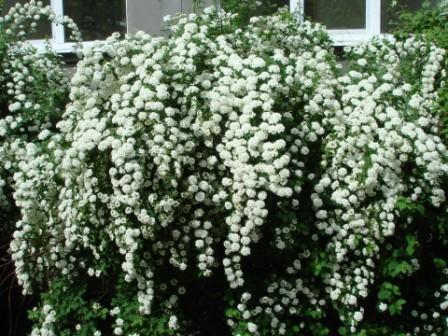
In the spring, the wolfberry will start the baton, filling your garden with an amazing aroma. In May, it will be replaced by Canadian irga, similar in its flowering with white tassels to bird cherry, in autumn it will decorate the garden with crimson leaves. At the end of spring, the spirea will enter the rights, inviting the bees with its snow-white fragrant flowers. On the border of spring and summer, lilac will pick up the baton with its lush flowering, filling the air around with delicate aromas. If you plant several bushes with different colors, the spring palette of your garden will rage with a variety of colors and delight the soul.
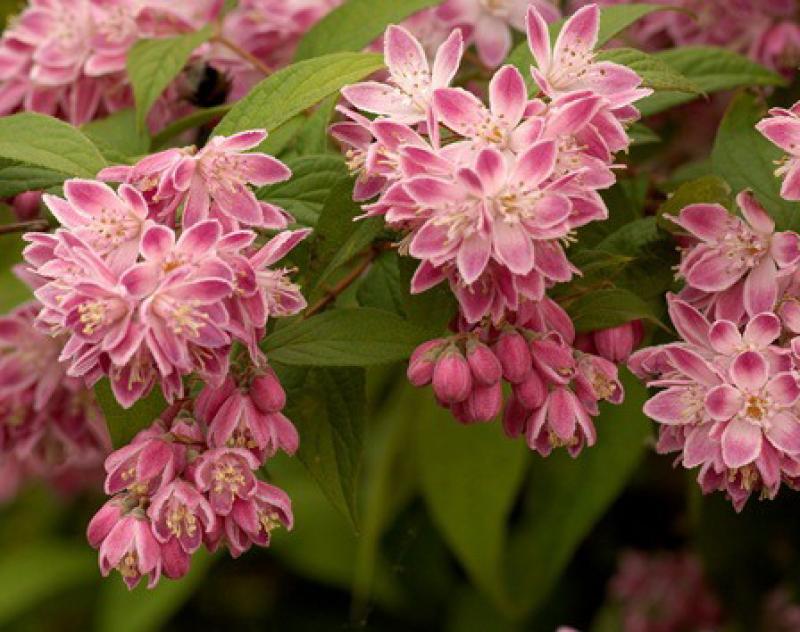
Summer shrubs take effect after spring ones. During this period, the skumpia begins to “smoke”, behind it the barberry blossoms with its yellow flowers, which by autumn will become red ripe clusters of berries. In June, the action begins to bloom and continues its flower parade until the end of July, decorating the garden with delicate white and pinkish flowers. In August, the Syrian hibiscus will begin to please with flowering, do not be too lazy to bring such beauty in the garden.
At the beginning of autumn, the lush royal hydrangea comes into play, decorating any area with its balls. Behind it, the heather with its variety of color palette creates a sense of celebration after the past summer, delighting with the beauty of flowering until late autumn. Cotoneaster, wild rose, mountain ash and hawthorn will decorate the garden until the very cold.
So, we sorted it out by the time of flowering. We have identified the most suitable shrubs for ourselves, let's now look at what features the above individuals have, because we have to settle them in the garden for many years, so you definitely need to know what kind of terrain suits them, are the conditions for caring for them too laborious, and decide, Which ones are right for your site? In addition, pay attention: - they will complement the flower extravaganza of your garden.
Peculiarities perennial shrubs

In spring, Japanese quince blooms most beautifully and brightest, tolerates drought well, reacts calmly to frosts, moreover, the older the bush is, it is not more frost-resistant, it is great for central Russia.
Jasmine is not whimsical, is not afraid of frost, he does not care about drought, a fragrant handsome man. Requires only a little feeding in the form of mullein and ash, and will bloom luxuriantly and delight you. Plant viburnum and hydrangea in his company, and your joy from contemplation will increase three times!
Jasmine - better choose domestic varieties, they are more adapted to our harsh winters. If you need kids, choose "Pearl", if you want up to 2 meters high, "Snowstorm" will do. Every month, fertilize with minerals, cut off old shoots and damaged ones, and in June-July you will enjoy the beauty of jasmine flowering to the fullest.

The spherical beauty hydrangea should be planted in partial shade. It does not tolerate calcareous soils, and if the soil in your garden is acidic, it will delight you with beautiful flowering. Moreover, the more acidic the soil, the more violently the hydrangea blooms, delighting with its beauty throughout August and September.
If you want to do hedge- plant a Syrian rose. She just needs a sunny place, but protected from drafts and winds - the very place near the fence or the wall of the house, where she will show herself in all her violent glory, turning into a fragrant vertical handsome carpet.
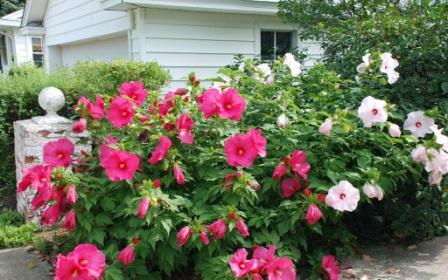
Lilac is the most popular inhabitant of our gardens, it can be of different colors, it can grow into a whole tree, therefore it requires constant pruning - it can grow up to 3 m high. In the spring, fertilize with bird droppings and remove damaged branches - that's all care. "Alima Harding" will bloom with white double flowers, "Paul Tyrion" will cover itself with purple blooms, and if you want to add a delicate blue color to the palette of garden colors, plant "Condorcet".
Japanese quince requires spring pruning of damaged shoots, and from the age of five, figured pruning should be done. Loosen the soil and mulch.
Hydrangea - the most winter-hardy is tree-like, for example, the Annabelle variety, cut in the fall, shorten the shoots in the spring up to the extreme bud. Subcortex with iron and magnesium is all that hydrangeas need for lush flowering.
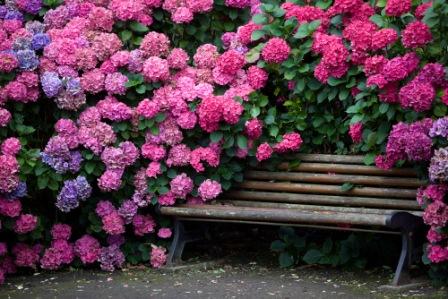
Creeping heather will delight you in the fall, but it needs proper soil with peat and sand. To plant it, replace the soil, add sawdust, spill with apple cider vinegar (half a glass is enough for a bucket of water). Water the plant with acidified water, mulch and add mineral fertilizers.
Following our advice, you can grow beautiful ornamental shrubs in your area that are suitable for your conditions, and you will enjoy magical flowering from spring to autumn. And how it will decorate your garden - be sure to plant this beauty, it will perfectly fit into any design of the site and bring its own zest to the garden.
Don't know how to separate the recreation area from the flower garden? Are you afraid that many low-growing branches are not suitable for our climate? Decorative flowering shrubs it will not be easy to separate the zones, but they will also delight with their beautiful and unusual colors. Consider the most popular flowering shrubs for central Russia in this short article. All considered shrubs feel great on our site, winter without problems and bloom profusely.
Flowering shrubs can be a real pride on your site.
Potentilla shrub or Kuril tea
Ornamental shrubs serve as a wonderful decoration for a flower garden or recreation area. One of them is cinquefoil or Kuril tea. Potentilla shrub or Kuril tea is difficult to appreciate during the flowering period of phloxes and roses, but it will emphasize their attractiveness without being ignored.
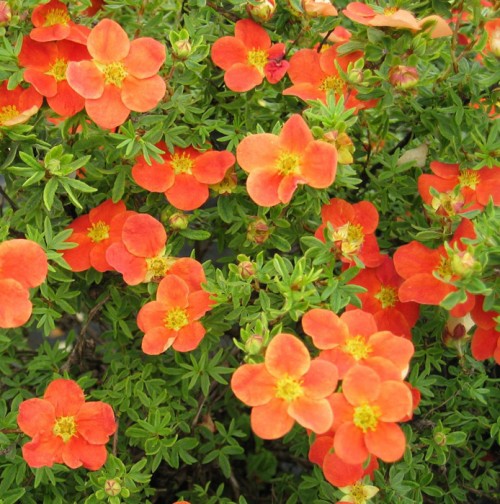 Kuril tea of any color is very delicate and beautiful.
Kuril tea of any color is very delicate and beautiful. It is a shrub with a branched crown, growing to a height of one meter with a long flowering period from July to September. This is one of the longest flowering plants. Potentilla flowers are similar to buttercup flowers 2-5 cm in size. Their color may differ from snow-white, yellowish to pink, as in the photo. In most varieties, the flowers are collected in umbellate or corymbose-paniculate inflorescences. Potentilla is loved for its beauty and unpretentiousness.
Potentilla is easy to cut and shape. This is best done in the spring before the buds open. Forming work is best done together: one holds the hoop, the other cuts off the extra shoots that go beyond it. So, a beautiful ball is formed.
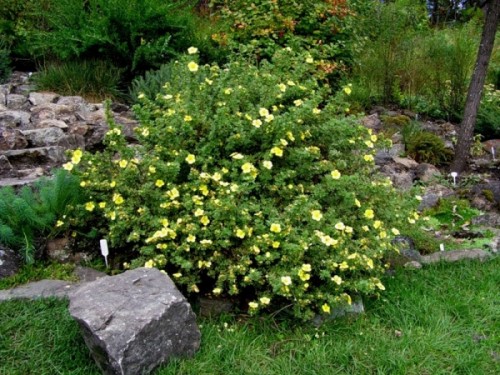 Potentilla can grow separately and will decorate any stone garden or alpine hill.
Potentilla can grow separately and will decorate any stone garden or alpine hill. Potentilla can also be used in hedges. The molding for this is different, just cut the top of the plant evenly. Cut branches can be rooted. To do this, cut the cuttings are placed in a wet mixture of peat and sand.
In the spring they can be planted in a permanent place. Pruning stimulates the flowering of the plant. Potentilla can conditionally divide the garden into a flower garden and a recreation area. A well-formed bush will decorate the flower garden.
It must be planted from the east or west of your site in light fertile soil, as Potentilla loves loamy soil, high in organic matter, well drained. The plant loves bright light. In low light, flowering is not intense. It is necessary to plant cinquefoil in early spring, but it is also possible at the end of summer.
The root system of the cinquefoil is located on the surface, so they dig a shallow hole for planting - 0.5–0.6 m. We fill the bottom with drainage from gravel or crushed stone of a fine fraction. We place a mash in the hole from a mixture of leafy soil, rotted organic matter and sand in a ratio of 2 - 2 - 1. We add complex mineral fertilizer to the finished hole with soil. When planting, we control that the root neck of the plant is above the level of backfilling with seedling soil. We sprinkle with earth, we mulch the near-stem zone and water it.
 Kuril tea needs to be looked after only so it will delight you with abundant flowering.
Kuril tea needs to be looked after only so it will delight you with abundant flowering. Potentilla likes frequent and regular watering. We feed the plant with any organic-based fertilizer once every 12 months and with a superphosphate solution according to the instructions for watering. We periodically loosen the earth around the plant.
The plant is disease-resistant and frost-resistant. Potentilla does not require shelter for the winter.
Potentilla is used in folk medicine. Her shoots contain a large number of vitamin P, carotene, essential oils. A decoction of the leaves has soothing, anti-inflammatory and antibacterial properties. From the apical shoots of Potentilla, tea can be brewed. The taste of tea is rich, beautiful reddish hue without bitterness. Kuril tea normalizes metabolism, has an immune-strengthening effect.
Buldenezh or decorative viburnum
Buldenezh got its name from French as "snow ball", which is very suitable for a shrub. This is an ornamental variety of viburnum. It will not please you with fruits and reproduces only vegetatively.
 Decorative viburnum will not leave anyone indifferent.
Decorative viburnum will not leave anyone indifferent. This shrub is good not only during the flowering period, covered with airy white flowers, as in the photo, but also in autumn, when the leaves turn purple. At the beginning of flowering, the flowers of the plant are greenish, but when ripe, they become snow-white. Buldenezh blooms from late May to mid-July. The plant prefers light, but blooms well in the shade. The plant has a well-developed root system, which makes it easy to endure drought times. Buldenezh is hardy and tolerates wintering well. The plant is undemanding to the soil, but it grows better on fertile soil.
Seedlings are best planted in early spring. We make the landing hole spacious enough. Its depth is at least 70 cm, and its width is 60–70 cm. We fill the bottom with a drainage mixture of gravel and sand. Compost is placed in the planting pit with the addition of nitrophoska and ash. When planting, it is allowed to deepen the neck of the rhizome by 3–4 cm. After planting, the seedling must be mulched and watered.
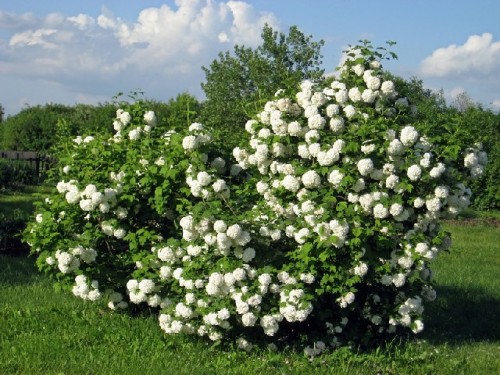 The Buldenezh bush during the flowering period pleases with large inflorescences in the form of balls.
The Buldenezh bush during the flowering period pleases with large inflorescences in the form of balls. The plant propagates vegetatively - by layering, dividing the bush and green cuttings. Suitable for central Russia. It is better to plant them in slightly darkened areas of the garden, as direct sunlight shortens the flowering period.
Buldenzh should be watered frequently and abundantly, followed by loosening the circle around the trunk. With normal refueling of the hole during planting, the plant can not be fed, but only for the first 24 months. Later in the fall, humus is introduced from manure. In spring, they are fed with mineral fertilizers.
The shrub is pruned once a year. Formative pruning is done in autumn, leaving the strongest shoots of the current year. Without pruning, the bush will be thickened, which reduces its decorative effect and reduces the abundance of flowering.
An ornamental flowering shrub must be treated with an insecticide against pests (mainly aphids).
During the flowering period, due to the weight of the branches, the bulldenezh needs support. More information about decorative viburnum is told in the video:
It is difficult to imagine a modern garden without flowering ornamental shrubs. Ornamental flowering shrubs have many benefits. Their maintenance is minimal, and the decorative effect is stable. For this, they enjoy well-deserved popularity of flower growers.
Shrubs are a very useful thing on the site. After all, with the right selection of plants, you can make the territory very aesthetically attractive. Shrubs can be different types, which further expands the possibilities for creative flight.
What are the benefits of planting ornamental shrubs for your garden?
- They serve as hedges, which can save money on a fence.
- With the help of shrubs, you can divide the site into separate zones.
- shrubs different levels together with a reservoir, it is an aesthetic center on the site.
- If there are places on the territory that look ugly, then it is with the help of shrubs that this problem can be easily solved.
So, the pros were mentioned a little, but how to choose the right plants for your garden. Everything is easier with flowers, but not everyone knows about shrubs. Below we will talk about garden ornamental shrubs, their types and features of choice for central Russia. It has its own nuances, the climate in the regions is harsh. We are talking not only about Russian winters, but also about strong winds, downpours, and hail.
Types of ornamental shrubs
Shrubs are classified according to different criteria. Depending on the height of the plant:
- undersized. The height of these types of shrubs does not exceed a meter. They have a compact shape. An example of such shrubs is the Japanese spirea, juniper;
- medium height. Their height can be from 1.5 to 2.5 meters. An example is common barberry, currant bushes;
- tall. Height over 2.5 meters. An example is lilac, elderberry, hawthorn.
Important point!
Speaking about the height of shrubs, it should be noted that this classification is relative. Since the height may be different depending on the dressings and their intensity, light, climatic zones, the use of growth stimulants.
Classification depending on the degree of growth:
- very fast growing. Shrubs grow up to 3 meters within two or three years. An example is acacia, mock orange;
- moderately fast growing. Viburnum ordinary, honeysuckle;
- with moderate growth. Cherry, lilac;
- slow growing. An example is sea buckthorn, Cossack juniper;
- very slow growing. Example − coniferous shrubs and deciduous dwarf species.
Classification according to life expectancy:
- with a short life span - the shrub lives less than 25 years. An example is elderberry, meadowsweet;
- with an average term - the shrub lives up to 30 years. An example is currant;
- centenarians - a shrub can grow up to 100 years. An example is common viburnum, lilac;
- with a very long lifespan - more than 100 years. An example is thuja.
Classification depending on temperature indicators:
- very thermophilic. Can die at minus 10 degrees. They are not suitable for central Russia;
- thermophilic. They require shelter, as the above-ground part often dies in the cold;
- moderately warm. Due to the long growing season, they have time to become woody;
- frost-resistant. They tolerate cold winters well, but may lose some of the shoots;
- frost-resistant. These species can withstand winter cold down to minus 50 degrees. This includes many coniferous shrubs.
So, we talked about the main species that exist in nature. Now let's talk about which shrubs are best planted in central Russia.
decorative deciduous shrubs
Not everyone knows about their existence. But it's time to catch up. After all, deciduous varieties are very fond of using landscape designers to decorate plots. They can be deciduous, that is, they shed their leaves during the cold season. They can be evergreen and fluffy.
Varieties of ornamental shrubs with leaves, for the most part, love well-lit places, fertile soil. They do not tolerate frost very well, so they need to be covered for the winter. One of the brightest representatives of deciduous shrubs, which is loved by the inhabitants of our country, is the Japanese maple.
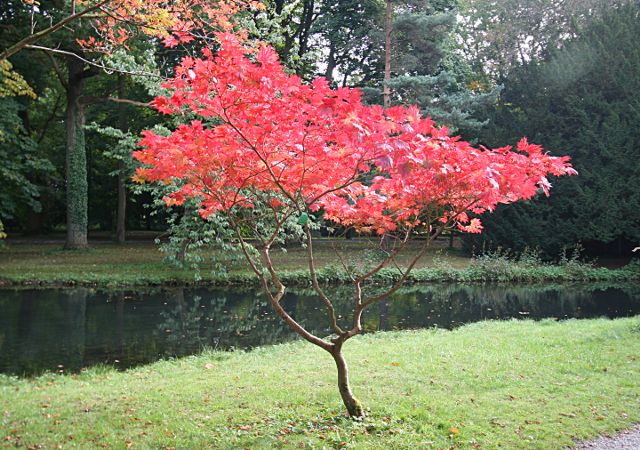 Japanese maple
Japanese maple
A beautiful plant that has carved large leaves. In autumn, they turn purple-red, which causes a lot of positive emotions. Such shrubs always collect a lot of views. They are hardy and grow fast.
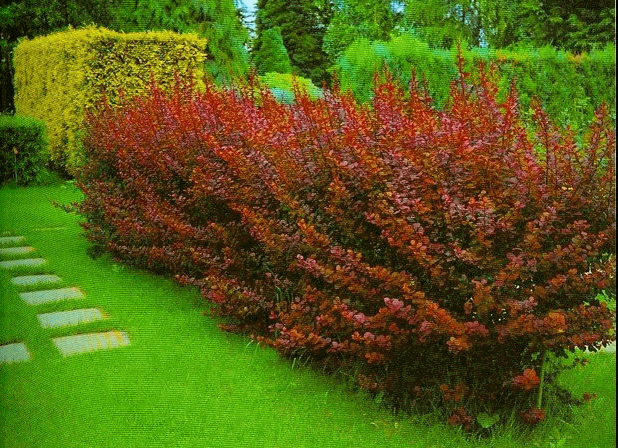 Barberry
Barberry
Also common in our country. A hardy spreading shrub. It easily tolerates shade, it is not very picky about soils. Barberry has not only thick leaves, but also small red berries, elongated. They are edible and useful. Used for compotes, for drying for the winter.
 Aralia
Aralia
Heat loving shrub. Loves light, warmth and fertile soil. It has straight large leaves. Good for site decoration.
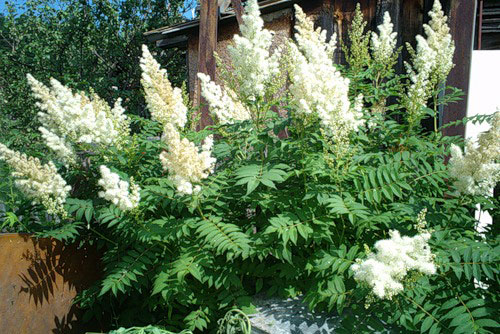 Fieldfare
Fieldfare
FROM last years they began to forget him, which is completely unfair. The shrub does not require any complex agricultural practices. It grows quickly, has beautiful leaves and flowers. Fieldfare aged looks spectacular. Speaking about the forgotten fieldfare, we must also mention the elderberry, which will also serve as an excellent decoration for the site.
Frost-resistant decorative flowering shrubs
When it comes to flowering plants, ideas of beautiful rose bushes, flower beds with an unusually pleasant aroma immediately appear in our thoughts. But not only flower beds, but also shrubs bloom. They look very advantageous in the garden, filling it with a delicate aroma. But far from all flowering shrubs are suitable for our country, as they can freeze out in winter. Which of them will endure our cold weather?
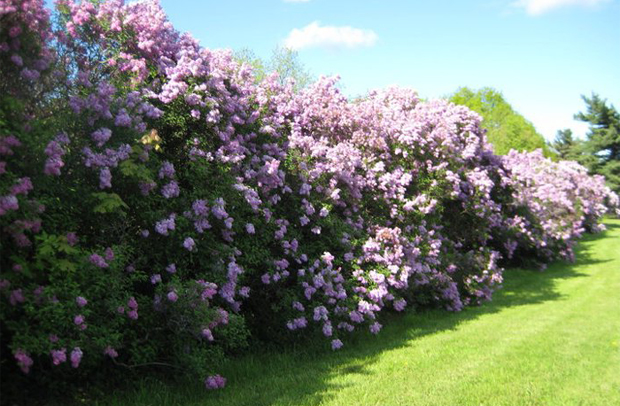 Lilac
Lilac
Who does not know this bush. Lilac is not whimsical, grows rapidly. It can be easily cut off. Grows in both shade and sun. Has different colors and shades.
 Spirea
Spirea
A very cute shrub that can have pale pink or white flowers. Under its weight, it spreads beautifully on the site. It can be cut to the desired shape. Tolerates frost well.
 Hydrangea
Hydrangea
Huge hats of various colors leave no one indifferent. Hydrangea tolerates cold very well. When grown unpretentious.
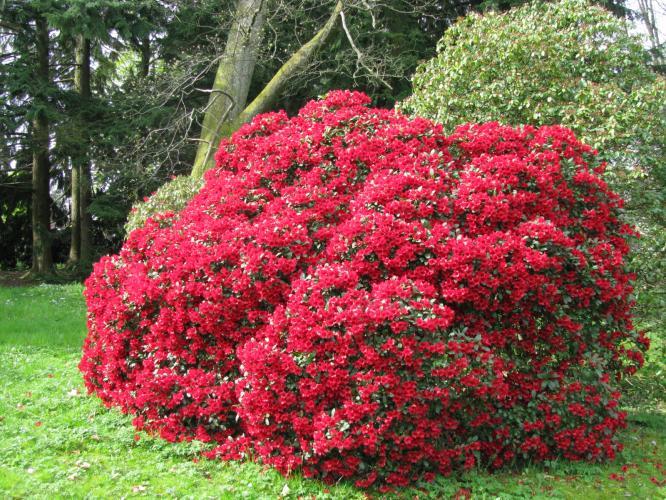 Rhododendrons
Rhododendrons
Very beautiful shrubs that can be of different types. They are unpretentious, can grow in marshy places. They tolerate winter well.
There are many ornamental flowering shrubs. You can plant viburnum, jasmine, cinquefoil, buddley, tree peonies on the site. This is a matter of taste and personal preference.
Perennial ornamental shrubs
There is a very wide variety of them. Most often in our country the following varieties of perennials are used.
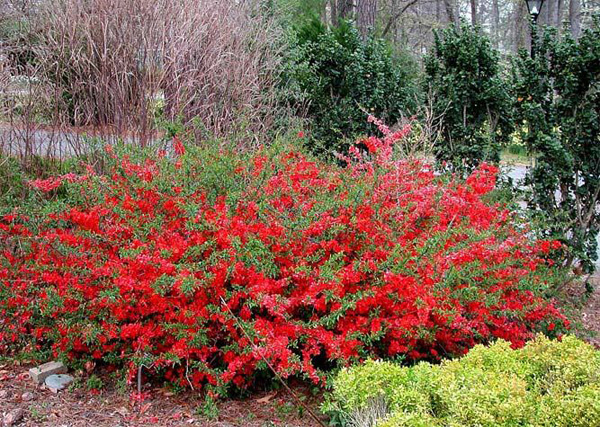 Japonica
Japonica
Beautiful shrub with interesting flowers. Often used for hedges.
 Weigela
Weigela
It is a favorite plant used in Japanese gardens. Most often it has pale pink flowers. A sprawling bush that looks very advantageous and spectacular on the site.
 Jasmine
Jasmine
This beautiful shrub It has not only cute flowers, but also a delicate aroma. When jasmine blooms, it exudes a scent that fills everything around. Very unpretentious shrub, very popular.
 Hibiscus
Hibiscus
It is believed that it is customary to use it for a hedge. Hibiscus is in high demand. Plots with it have a very attractive and luxurious look.
Low growing ornamental shrubs
Low-growing shrubs look very beautiful on the site, while they do not require complex pruning. They are good to use for small gardens or for arranging the lowest level in a flower bed. However, they do not require frequent watering, love the sun.
 Heather
Heather
Grows in many countries of the world. Used in medicine, unpretentious. Has small flowers. Most often purple or pinkish. Heather looks great on the site. But in a harsh climate, it is better to cover it for the winter.
 polyanthus roses
polyanthus roses
Roses are roses. They are always the prettiest. At the same time, it is these roses that are unpretentious, bloom all season until the cold weather, and do not require complex care. The bush is usually no more than 50-60 cm high. Flowers are about 3 cm in diameter.
 dwarf barberry
dwarf barberry
Often used for landscape design. Looks good on the site, easily tolerates pruning. There are different types.
Spirea can also be attributed to undersized varieties. We talked about it above.
Evergreen ornamental shrubs
We all know from childhood that green in both winter and summer is a Christmas tree. But it is large. The bottom line here is that evergreen shrubs are also conifers. This is, for example, juniper. But there may be other evergreen shrubs, such as rhododendron, heather, boxwood, holly.
As you can see, there is a wide variety of shrubs. Each of them is beautiful in its own way. Do not be afraid to experiment, plant different varieties, read about them, observe.
Ornamental shrubs are planted in a suburban area in order to fill and diversify the surrounding space. Bright inflorescences, fragrant aroma and unique coloring of the leaves of most shrubs make them welcome guests on our site. Shrubs perform not only a decorative function, but they also protect the site from noise, dust and wind.
There is a large assortment of ornamental shrubs with different shades of foliage, fruit color, and inflorescence shape.
What qualities should a shrub have?
Ideally ornamental shrub- this is a well-adapted plant to the conditions where it grows, not demanding for careful care and retaining its decorative effect throughout the season.
What attracts such shrubs to our attention? First of all, beautiful and fragrant flowering, different shades of foliage, decorative fruit in autumn, when the foliage has already fallen.
Some of the shrubs are practically not affected by diseases and pests, and it is not difficult to care for them.
Properly selected flowering shrubs in the garden can bloom continuously from early spring to late autumn.
The most persistent and beloved by many gardeners shrubs.
Not a single suburban area can be imagined without the aroma that gives . This fast growing shrub up to 3m high. can be planted in the far corner of the garden, its aroma will be heard at a great distance, and dense greenery can hide unsightly garden buildings. For abundant flowering, strong pruning every 2-3 years is recommended.
From May to June, it blooms spectacularly in the garden with huge snow-white inflorescences. . It is a fast growing shrub up to 3m high. with a wide spreading crown. Viburnum "Buldenezh" does not form fruits, tolerates harsh winters well, and to enhance flowering, it is recommended to carry out radical rejuvenating pruning.
Decorative deciduous shrubs are used by landscape designers to decorate the garden from early spring to late autumn. Numerous barberry varieties amaze the eye with the variegation of leaves of purple, bright yellow, bright green. All barberries tolerate pruning well and can be planted along the path as a beautiful clipped hedge.
Among the unpretentious ground cover occupies a place of honor. A low compact cinquefoil bush blooms from June until the start of frost. Its plus is that it does not require care and even a novice gardener will be able to grow it on his site. Modern varieties have large brightly colored flowers that do not fade in the bright sun, and to stimulate flowering, you need to cut the bush every few years to a height of 10 cm above the ground.
Along unattractive garden fences, we recommend planting sod or svidina. Beautiful bright red shoots turf white "Sibirika" or variety with variegated leaves that turn red in autumn "Sibirika Variegata" great for planting along fences. Their shoots in winter in a leafless state look very decorative. Derain tolerates pruning well, after shearing the shoots become more intense in color.
What could be more reliable than a hawthorn if you need to plant a thick impenetrable hedge? will cope with this task perfectly, it is a fast-growing small tree, forming which you can create a powerful living wall. The crown is dense, the leaves are glossy green, the fruits are edible, kept on the shoots until winter.
For landscaping a large area, when you need an unpretentious and budget option, suitable , which takes root even on the poorest soil. It is not whimsical, tolerates drought well, can grow with equal success both in sunny and shaded areas. Cotoneaster is ideal for creating clipped hedges from 30 to 80 cm in height, cut in early spring.

When planting shrubs, it is preferable to create group plantings of the same variety or combine different forms of shrubs of the same genus
With the blooming of each flower, the garden takes on a new look, and every year you want to see the flowers you like again. Therefore, gardeners love perennials. But another way to admire flowering every year throughout the season is flowering shrubs for summer cottages and garden plots. There are more than 200 species of such ornamental plants, completely different from each other and blooming their buds from the earliest spring to almost autumn. We will talk about the most interesting bushes and tree-like vines that you can plant alone, make interesting compositions, decorate a house, terrace, fence.
Jasmine
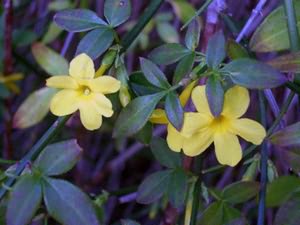 The very first, back in February, among the snow and frost, jasmine blooms. And in regions where the temperature does not drop below -10 degrees in winter, the jasmine hololithous blooms the first yellow flower stars in November - and they bloom all winter. In our gardens, you can grow about 10 types of jasmine with white, yellow, pink or red flowers. They bloom at different times. For example, jasmine officinalis opens its pink buds all summer, from June to the end of September, and its shoots grow up to 8 meters. Shrub jasmine low blooms in May-June with yellow flowers. A feature of all species is an unusually pleasant aroma. Decorative jasmines do not require special conditions, except for a sunny place. Propagated by layering and cuttings in a greenhouse in July.
The very first, back in February, among the snow and frost, jasmine blooms. And in regions where the temperature does not drop below -10 degrees in winter, the jasmine hololithous blooms the first yellow flower stars in November - and they bloom all winter. In our gardens, you can grow about 10 types of jasmine with white, yellow, pink or red flowers. They bloom at different times. For example, jasmine officinalis opens its pink buds all summer, from June to the end of September, and its shoots grow up to 8 meters. Shrub jasmine low blooms in May-June with yellow flowers. A feature of all species is an unusually pleasant aroma. Decorative jasmines do not require special conditions, except for a sunny place. Propagated by layering and cuttings in a greenhouse in July.
Japanese keria is completely unpretentious either to soils or to the place of growth. It blooms brightly, luxuriantly and for a long time from mid-April to June with shaggy, papery yellow flowers. There are decorative varieties in which the petals have a white or cream border. In July-August there may be a second wave of flowering, but not so abundant. This shrub requires annual formative pruning after the first bloom. Propagated by root shoots or cuttings in June.
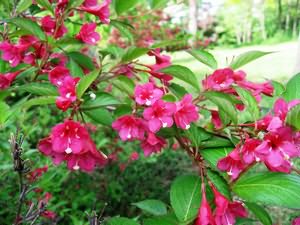 This is one of the best decorative flowering shrubs. Weigela lends itself perfectly to a haircut, but it looks even more beautiful in a single planting - with long curved branches, literally plastered with bright pink or pale flowers. There is also a weigela, in which the flowers are yellow or cream - Middendorf, the Eva Rathke variety blooms in rich red. There are many varieties with colored, speckled and variegated leaves. Weigela blooms twice a season - in spring and autumn. After flowering, it requires pruning, propagated by cuttings planted in autumn directly into the ground.
This is one of the best decorative flowering shrubs. Weigela lends itself perfectly to a haircut, but it looks even more beautiful in a single planting - with long curved branches, literally plastered with bright pink or pale flowers. There is also a weigela, in which the flowers are yellow or cream - Middendorf, the Eva Rathke variety blooms in rich red. There are many varieties with colored, speckled and variegated leaves. Weigela blooms twice a season - in spring and autumn. After flowering, it requires pruning, propagated by cuttings planted in autumn directly into the ground.
 Or a more correct name - wisteria. This is a tree-like liana that blooms in April-May of incredible beauty with purple, white or pink tassels. In some hybrid varieties, decorative brushes can reach up to 80 cm in length! It is a very popular plant in Japan, where entire streets are adorned with wisteria. Interestingly, its shoots curl counterclockwise and can reach up to 30 m in length. The first time blooms only 5 years after planting. In July, it is recommended to shorten its side shoots. Wisteria can be propagated by buried layers or lignified cuttings in the summer under a jar. Plant this vine near a gazebo, fence or old tree, and it will give you a flowering festival every spring for many years. Wisteria lives for more than 200 years.
Or a more correct name - wisteria. This is a tree-like liana that blooms in April-May of incredible beauty with purple, white or pink tassels. In some hybrid varieties, decorative brushes can reach up to 80 cm in length! It is a very popular plant in Japan, where entire streets are adorned with wisteria. Interestingly, its shoots curl counterclockwise and can reach up to 30 m in length. The first time blooms only 5 years after planting. In July, it is recommended to shorten its side shoots. Wisteria can be propagated by buried layers or lignified cuttings in the summer under a jar. Plant this vine near a gazebo, fence or old tree, and it will give you a flowering festival every spring for many years. Wisteria lives for more than 200 years.
 Very popular blooming perennial bush arnica with white or pale pink flowers. It grows no more than 1.5 meters, blooms in the summer, almost 2 months, very abundant. The action is completely undemanding to growing conditions, it is recommended to cut off the faded shoots only after flowering. To propagate this shrub, it is enough to dig cuttings 10-15 cm long in the fall, and in the spring they will already start growing. The action is very fond of aphids, so it should be planted away from garden crops.
Very popular blooming perennial bush arnica with white or pale pink flowers. It grows no more than 1.5 meters, blooms in the summer, almost 2 months, very abundant. The action is completely undemanding to growing conditions, it is recommended to cut off the faded shoots only after flowering. To propagate this shrub, it is enough to dig cuttings 10-15 cm long in the fall, and in the spring they will already start growing. The action is very fond of aphids, so it should be planted away from garden crops.
Cercis
A tall shrub with a spreading crown, which eventually becomes like a tree. It blooms in May-June with very bright pink-lilac flowers that cover the entire length of the stems. Pruning should be done carefully in early spring. You can propagate by seeds, or in the fall you can add layering.
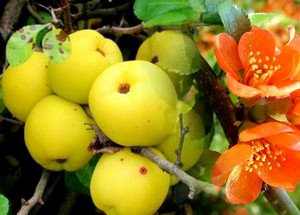 This wonderful bush not only blooms for almost the whole May with bright, large orange or red flowers, but even in autumn it will delight with fragrant fruits, resembling quince in taste and appearance, only the size of a large nut. Japanese quince grows both in the sun and in the shade, it is not necessary to cut it. If you plant chaenomeles against a wall, then it will stubbornly grow along it, decorating an ever larger surface.
This wonderful bush not only blooms for almost the whole May with bright, large orange or red flowers, but even in autumn it will delight with fragrant fruits, resembling quince in taste and appearance, only the size of a large nut. Japanese quince grows both in the sun and in the shade, it is not necessary to cut it. If you plant chaenomeles against a wall, then it will stubbornly grow along it, decorating an ever larger surface.
Spirea
This is probably the most common shrub in our parks and gardens. Some species forms more than a hundred. Spirea is a favorite bush of breeders who have bred a myriad of varieties. There is a spirea that blooms in early spring with white or pink corymbs, and there is one that blooms in autumn until frost. The most beautiful and famous representatives:

All spireas are undemanding to conditions, propagate by cuttings directly into the ground or by dividing the bush.
 If you are looking for flowering garden shrubs that are decorative all year round, then be sure to plant the holly mahonia. This evergreen shrub in spring (and there are species that bloom in autumn) blooms with very fragrant yellow flowers, blue-black berries adorn it all summer, and glossy leaves turn bronze or purple in winter. The bush can be propagated by root shoots.
If you are looking for flowering garden shrubs that are decorative all year round, then be sure to plant the holly mahonia. This evergreen shrub in spring (and there are species that bloom in autumn) blooms with very fragrant yellow flowers, blue-black berries adorn it all summer, and glossy leaves turn bronze or purple in winter. The bush can be propagated by root shoots.
This picturesque shrub is rarely found in our gardens, but in vain. In the month of May, its arcuate decorative shoots are covered  a huge number of pink drooping flowers. Kolkvitsia must be cut after flowering, otherwise it will grow up to 3 meters in height. Propagated by ordinary cuttings.
a huge number of pink drooping flowers. Kolkvitsia must be cut after flowering, otherwise it will grow up to 3 meters in height. Propagated by ordinary cuttings.
Hydrangea
The flowering shrubs also include the hydrangea, beloved by everyone, blooming all summer. And if ordinary species know everything, then pay attention to varieties such as Sargent's hydrangea, Grandiflora or climbing hydrangea.
Hibiscus Syrian and herbaceous
 This tree-like shrub, despite its southern origin, perfectly tolerates the most severe winters and will bloom tirelessly every year from early July until the very cold. The flowers are white, pink, lilac, purple, red. Hibiscus herbaceous is a perennial bush with incredible beauty of all colors and sizes of flowers, but its shoots must be cut every year at the root. All hibiscus reproduce by seed.
This tree-like shrub, despite its southern origin, perfectly tolerates the most severe winters and will bloom tirelessly every year from early July until the very cold. The flowers are white, pink, lilac, purple, red. Hibiscus herbaceous is a perennial bush with incredible beauty of all colors and sizes of flowers, but its shoots must be cut every year at the root. All hibiscus reproduce by seed.
Hebe
A magnificent evergreen shrub that blooms brightly and profusely with rather rare blue, blue, lilac, pink and even gray tassels. Chebe, of which there are almost 200 varieties, are favorite ornamental perennial shrubs in Europe, and now they are confidently conquering our gardens.
Buddley
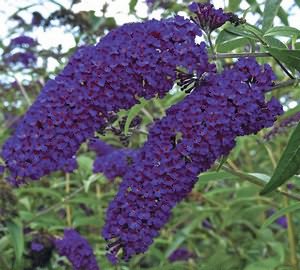 One of the most beautiful shrubs that blooms in summer, attracting hundreds of butterflies with its amazing fragrance. Two types of buddley are popular with us: David, in which candle inflorescences can reach up to 30 cm and be from pure white to black, and alternate-leaved buddley - with long hanging branches densely covered with blue flowers. Both species can be propagated by cuttings directly into the soil in the fall.
One of the most beautiful shrubs that blooms in summer, attracting hundreds of butterflies with its amazing fragrance. Two types of buddley are popular with us: David, in which candle inflorescences can reach up to 30 cm and be from pure white to black, and alternate-leaved buddley - with long hanging branches densely covered with blue flowers. Both species can be propagated by cuttings directly into the soil in the fall.
You can describe for a long, long time what wonderful shrubs you can plant in your dacha, but this cannot be contained in one article. Therefore, further we will simply list their names, and you will find more detailed information on the pages of our website. So, pay attention to such shrubs:

LetovSadu.ru
Perennial flowering shrubs, as well as the rules for planting and proper care for them
Today, not a single garden plot is complete without beautiful bushes. The same applies to park areas, squares and even small flower beds. You can dilute the boring image of gardens and plots with perennial shrubs. They help to delineate the boundaries of the garden, giving it a special showiness.
You can choose plants by size and color. In addition to beautiful flowering, shrubs also surprise with their exquisite aromas. In addition, these plants are not whimsical in care and are resistant to various diseases.
The best shrubs for the garden
Lilac. This is a diverse flowering shrub with about ten species. This plant is quite frost-resistant, so it can be grown in any temperate climate. The only drawback of the shrub is that after flowering it does not look attractive enough.
Spirea. This is an ornamental plant with fluffy flowers. Varieties of spirea have different flowering periods. Thanks to this, it is possible to ensure a continuous change in the garden colors shrubs. In turn, the aroma of the plant will attract various insects for pollination. After all, spirea is also an excellent honey plant.
Forsythia. It is a perennial shrub of the olive family. It has yellow flowers resembling bells. The uniqueness of this plant lies in the fact that it first blooms, and then releases leaves with young shoots.
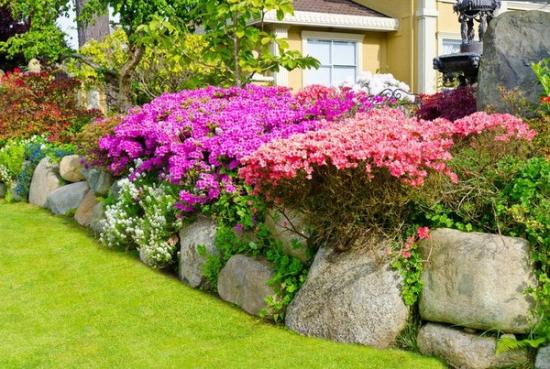
Decorative almond. This is a spring flowering plant. A shrub blooms 4-5 years after planting. Almonds do not require special care and grow quite quickly. When its old trunks die off, they are gradually replaced by new root offspring. In addition to all the plants listed above, you can decorate your site with such perennials as: barberry, weigela, wolfberry, keria, etc.
Planting and caring for perennial shrubs
Considering the fact that ornamental plants grow in one place for many years, it is necessary to carefully choose the soil for them. If most of the shrubs are represented by light-loving forms, then it is better to plant them in shaded places.
For intensive growth plants, the ground must be pre-treated with organic fertilizers. As for planting, shrubs can be planted both in spring and autumn. In spring, planting should take place immediately after the snow melts, and in autumn - during leaf fall.
For autumn planting, holes need to be dug in the summer. The diameter and depth of the finished pit should be 0.6 m. If only sand is present in the soil, then a little clay should be added to it, on top of which fertile soil will be poured.
Video about a beautiful shrub for a garden - skumpii:
Planting should take place in cloudy weather. Plants ready for planting should have a strong root system. The age of seedlings should not exceed five years. Fresh seedlings should be immediately buried in prepared pits, otherwise the roots may dry out. After planting the plant, make a hole around it and pour two buckets of water into it.
Thus, the soil around the roots is compacted. The trunk circle of a watered plant can be mulched with peat, or fallen needles. Mulching the soil helps prevent moisture from evaporating.
Further care for planted shrubs consists in watering and cutting off weak and broken shoots. If the shoots are too long, then they also need to be cut. This is done in order to restore the physiological balance of the damaged root system. Throughout the growing season, plants need to be watered very often. Also during this period, you need to apply mineral fertilizers.
We create a garden of perennial shrubs
The correct creation of a garden or a flower garden with perennial shrubs takes place in several stages, for example, determining the style, distributing colors, etc. Style definition. The design style can be landscape or formal. Also, these two styles can be mixed by planting plants along the paths, in symmetrical lines. At the same time, in the center of the garden, you can place a composition in country style. Such a garden will need careful and regular maintenance.

Definition of a viewpoint. It is necessary to pay attention to those points from which the composition will most often be observed. First of all, it is necessary to take into account the color and texture of the shrubs. Blue colors should be placed close to the viewpoint, while bright colors are best perceived at a far distance. Shrubs with large flowers should also be placed away from the vantage point, and plants with small inflorescences should be placed in the foreground.
Color distribution. If the garden is monochrome, then only one color is taken as the basis, under which all other plants will be selected in the future. As a rule, the shades of all selected plants should correspond to the main color chosen.
Harmonious gardens combine two or three colors. The main thing is that these combinations are easy to understand. All perennial shrubs must be selected according to the flowering period in order to provide them continuous flowering. If a flower bed is planned on the territory of the garden, then when designing it, you should follow several rules. Most high grades plants should be placed in the middle of the flower bed. Further, the placement of shrubs takes place as it decreases.
Undersized flowers are planted along the borders. You also need to take into account the fact that the flower heads always turn to follow the sun. Therefore, so that the flowers do not turn in the opposite direction, it is best to plant those varieties that are least responsive to the sun's rays. These plants include: lupins, irises, delphinium, zinnias and marigolds.
In the process of planting perennial shrubs, a certain distance must be left between them, as they will grow over time. Also, when selecting plants, you need to pay attention to the fact that some varieties tend to close after dinner (bindweed). And such a flower as mattiola closes closer to the night. So that the flower bed can delight with its flowering all year round, some varieties of annuals can be added to perennial plants.
OgorodSadovod.com
Overview of the most popular perennial shrubs for summer cottages with photo examples
Landscaping the garden is the most important component of the landscape design of the site. The importance of plants in the design of a dacha can be felt when walking along the city streets - the dullness of concrete walls and asphalt simply requires rest in a green garden. Shrubs are one of the most popular gardening plants. In this article, we will very briefly consider the most popular types of shrubs that can be used in an original and useful way to equip a summer house and a garden.What shrubs to choose for a small garden?
Since shrubs are famous for their small stature and large width, owners of small summer cottages need to choose less voluminous shrubs so that they fit in a tiny garden. Most suitable shrubs for the garden in this case are:
Forsythia is one of the earliest flowering shrubs, which pleases with its yellow and light green colors in early spring, when all other shrubs and trees are still completely bare. Forsythia has a small size, so it is ideal for a small garden.
forsythia
Another option for a low shrub for the garden is the Japanese rhododendron, which has a wide range of colors and can blend well with the rest of the plants in the garden.
Japanese rhododendron
In order to continue the baton of flowering shrubs in a small garden, it is recommended to use lilac, which begins to bloom closer to summer.
AT summer time brightly complement the composition blooming garden kolquitsia, which will give the cottage a pleasant aroma.
In order for a small garden to bloom in the autumn, it is recommended to place within it various types of hibiscus, the color range of which ranges from bright white to purple.
Hibiscus
Well, in order for the garden plot not to do without decorative equipment with plants in winter, it is recommended to add dwarf spruce or arborvitae to the assortment of plants.
dwarf spruce
What shrubs to choose for a large garden?
In this case, you can use any shrubs you like and plant them not only alone, but also in mixborders, green hedges, etc.
So that, again, the shrubs in the garden will delight us all year round, it is necessary to select their combination, which ensures the flowering of one group of shrubs at a time when others will already finish the flowering period. Let's bring to your attention the types of shrubs that bloom in a certain season:
- Spring: all the same forsythia, Japanese quince, spirea, keria, almonds, canadian irga, wolfberry (be careful with it, because it is very toxic) and others.
- Summer: barberry, hydrangea, action, weigela, mock orange, skumpia, etc.
- Autumn: hydrangea, heather, mountain ash (which also never ceases to delight with the colors of its fruits in winter), dog rose, cotoneaster, hawthorn, etc.
The most popular perennial shrubs
There is a very wide range of perennial shrubs that can brightly complement the garden on suburban area, but the following 4 plants are considered the most popular and attractive:
samdizajner.ru
Border flowers and perennial plants: photo in the catalog and names
Before you on this page is a large catalog of border flowers and plants that allow you to beautifully design garden paths, flower beds and rockeries. Here you will find the names of border colors, and read short descriptions their agricultural properties. Photos of border flowers in various stages of their vegetative development will help to appreciate the beauty of all this diversity. For the most part, border flowers are plants that are resistant to trampling and soil compaction. Perennial border flowers are preferred for breeding on the site, since they do not require mandatory planting in the spring, when the gardener has so many worries.
Perennial border plants and their photos
Most border plants are classified as hardy perennials. Depending on their height, perennials are isolated for a rock garden or border. These are border perennials that are grown in one place without digging for the winter year after year, although the leaves and peduncles of most of them die off in winter. You can see perennial border plants at their best at the height of summer in a well-planned herbaceous border, although these days mixed borders (mixborders), composed of perennials, bulbs, shrubs, etc., are more common than flower beds, entirely of perennials. herbaceous plants. And now look at the border plants in the photo presented on this page.
ZYVUCHKA - AJUGA
- Location: sunny or slightly shady
- Reproduction: division in autumn
An easy-to-grow perennial that is planted for its evergreen, colorful leaves rather than the small flower clusters that appear on short spikes in late spring.
The brightest flower decoration is the creeping tenacious (A. reptans) ‘Alba’ 15 cm high. Any garden soil will do.
border flower agapanthus
The agapanthus border flower is suitable for long-term gardening due to the long flowering period.
- flowering time: July - September
- Location: best sunny
- reproduction: division in spring
Inflorescences of funnel-shaped flowers appear on long peduncles above belt-shaped leaves. Each flower is about 5 cm in diameter and usually blue in color. Plants of the most popular variety type - 'Headbourne Hybrids' - reach a height of 75 cm. It is not quite hardy and requires shelter for the winter.
AKANTHUS
- Location
- reproduction: fall division
This plant is grown for its beautiful flowering and foliage. It has large, deeply dissected openwork leaves. Tolerates drought well. Does not like heavy structureless soils. After flowering, cut off the aerial part close to ground level.
Prickly acanthus (A. spinosus) - reaches 1.2 m in height. AKANTH soft (A. mollis) is taller and has soft spines.
ANEMONE, ANEMONE - ANEMONE
- Location: sunny or slightly shady
- reproduction: segments of rhizome
Unlike the short tuberous anemones, these are tall, curb perennials that produce white or pink flowers 5 cm in diameter. The leaves are deeply dissected. The usual choice is varieties of Anemone hybrid (A. hybrida) with a height of 90 cm to 1.5 m. Cover the bushes for the winter with mulch.
VOLOVIK, ANKHUZA - ANCHUSA
- flowering time: June August
- Location: best sunny
Reproduction: division in the spring. The perennial anhuza is an unattractive plant - its rambling stems need support, the large leaves are rough, and it is short-lived. However, few flowers can compete with the bright blue Ankhuz flowers in the border. The most popular variety is A. azure (A. azurea) ‘Loddon Royalist’ 90 cm high.
PUPAVKA - ANTHEMIS
- Location: best sunny
- reproduction: fall division
A bright plant for the front of the border. The foliage is thinly dissected, and Chamomile - prominent inflorescences appear periodically throughout the summer. Each inflorescence has a central golden disk, and the reed flowers are white or yellow. The dye umbilical (A. tinctoria) has a height of 60 cm.
VOLZHANKA, ARUNCUS - ARUNCUS
- Location: penumbra
- reproduction: fall division
Volzhanka ordinary, or dioecious (A. dioicus) - a tall plant up to 1.8 m. Cirrus sultans of tiny cream flowers rise above a fountain of pale green leaves. For most gardens, a more compact type is preferred - pay attention to the 1.2 m high Volzhanka 'Glasnevin' or the 30 cm high dwarf Volzhanka (A. aethusifolius).
ASTRA - ASTER
- Location: best sunny
- reproduction: fall division
New Belgian asters (A. novibelgii) are the most popular asters, but not the easiest to grow - powdery mildew can cover the whole plant with a gray bloom. The usual height is 60-90 cm. The New England Asters (A. novae-angliae) group of varieties is similar to them, but has good resistance to powdery mildew.
What to grow border flowers in the country?
Now it’s worth talking about what kind of border flowers in the country can be grown, taking into account the fact that you will not be able to provide constant watering and care for them.
BADAN - BERGENIA
- Location: sunny or partial shade
- reproduction: fall division
This groundcover grows well under trees, spreads quickly, suppresses weeds, and provides foliage color all year round. In spring, hyacinth-like flowers appear. Typical species - Badan hearty (B. cordifolia) 45 cm high - choose from white, pink or red hybrids. Remove dead leaves in spring.
BELL - CAMPANULA
- Location: sunny or slightly shady
- reproduction: division in spring
You will find varieties of this plant with bell-shaped or star-shaped flowers for the front middle and back of the border. There is a Bellflower (C. lactiflora) 'Loddon Anna' - height 30cm, Bellflower peach (C. persicifolia) - height 60-90 cm and Bellflower broadleaf (C. latifolia) - height 1.2-1.5 m. blue and lavender.
CENTRANTHUS - CENTRANTHUS
- Location: best sunny
- reproduction: sowing seeds under glass in March
A wonderful plant for a cottage garden - you will find it growing on old walls and rocky soil. Kentrantus red (C. ruber) 45 cm high has pink flowers, but there are both red and pink varieties. Plants are short-lived, but they reproduce in abundance by self-sowing. Not the best choice if drainage is poor.
CANNA - CANNA
- Flowering time: July - October
- Location: sheltered sunny position
Propagation: By cuttings of germinated canna rhizome in bloom, it provides an attractive focus for the center of a flower bed with flower beds. Bright flowers are up to 10 cm in diameter, and large leaves are often colored. Canna garden (C. generalis) with a height of 60 cm to 1.2 m has many varieties. Rhizomes are planted in June.
LILY OF THE VALLEY - CONVALLARIA
- Location: partial shade is best
- reproduction: division in October
Graceful bells on arched peduncles appear at the same time as the lanceolate leaves - an excellent choice of groundcover with spring flowers for shady areas. May lily of the valley (C. majalis) 25 cm high has many varieties. 'Prolificans' flowers are double, 'Rosea' flowers are pink, and 'Albostriata' flowers have green stripes on the flowers.
CHRYSANTHEMUM - CHRYSANTHEMUM
- flowering time: usually september - october
- Location: best sunny
- reproduction: division in spring
These small-flowered chrysanthemums are hardy, but in autumn they are cut and covered with mulch. There are Korean hybrids - 60-90 cm high, Rubellum hybrids - 90 cm high and, finally, cushion-shaped, which form leafy mounds 45 cm high.
We form border flower beds
Beautiful border flower beds- this is a newfangled trend in landscape design. We form border flower beds using the plants listed below.
COREOPSIS - COREOPSIS
- Location: best sunny
- reproduction: division in spring
The yellow flowers appear in abundance on thin spikes - a great choice if you're interested in a floral arrangement. Whorled coreopsis (C. verticillata), 60 cm high, and its cultivars are a popular choice. Variety ‘Grandiflora’ with large inflorescences; ‘Moonbeam’ with lemon yellow. K. pink (C. rosea) ‘American Dream’ has pink inflorescences.
DICENTRA, DICLITRA HEART BROKEN - DICENTRA
- flowering time: May - July
- Location: best sunny
Reproduction: Arcuately curved peduncles over openwork leaves bear flowers in the form of a medallion. She needs a place protected from cold winds - she grows quite successfully under trees. A popular choice is D. spectabilis 60 cm tall, but D. eximia hybrids are the best choice.
DORONICUM - DORONICUM
- Location: sunny or slightly shady
- reproduction: division in May
There are many yellow daisy flowers for the border - choose this one if you want spring bloom. In many borders, Doronicum provides the first splash of color of the season. A popular choice is Doronicum high (D. excelsum) ‘Harpur Crewe’ 90 cm high with 8 cm inflorescences.
ECHINACEA - ECHINACEA
- flowering time: July - October
- Location: best sunny
Propagation: A prominent feature of this late-flowering border perennial is the pineal center of each inflorescence, surrounded by down-curved petals. A popular species is Echinacea purple (E. purpurea) with a height of 90 cm - 1.5 m. The variety ‘White Swan’ has a yellow center and white petals.
MORDOVNIK - ECHINOPS
- Location: best sunny
- reproduction: fall division
An upright plant for the middle or back of a border. Inflorescences are spherical, and on strong peduncles deeply dissected leaves. Wear gloves when handling it. Does not grow well in shade or thin soil. The usual choice is common Mordovnik (E. ritro) 1.5 m high. There are pale and dark blue varieties.
beautiful border garden flowers
SYRINGIUM -ERYNGIUM
- Location: best sunny
- reproduction: division in spring
Thistle-like leaves form a rosette, and inflorescences with spiny marginal flowers open on branched peduncles. Flowers persist for many months. The evergreen flat-leaved eryngium (E. planum) 90 cm high is popular, as is the variegated eryngium (E. variifolium), in which the leaves have white veins.
Jaundice - ERYSIMUM
- Location: best slightly shady
- reproduction: fall division
The tiny flowers appear in showy plumes - leaves deeply dissected and often copper-red in spring. There are a large number of hybrids with many colors in height from 30 to 90 cm. Moist, humus-rich soil is needed. There are several dwarf hybrids 15 cm high for a rocky garden.
FUCHIA - FUCHSIA
- Location: sunny or slightly shady
- reproduction: cuttings under glass in July
Plants in this group are hardy and produce graceful branches with hanging flowers year after year. These stems die from frost; in areas with the mildest climate, the stems become woody and permanent, forming a flowering shrub. The most popular species is Magellanic Fuchsia (F. magellanica) with a height of 1.2 m.
Gaillardia - GAILLARDIA
- Location: best sunny
- reproduction: division in spring
Large inflorescences with a diameter of 5-10 cm continue to appear from early summer to autumn. Colorful, but a poor choice if there is a problem with drainage. The usual type is one of the hybrids of Gaillardia large-flowered (G.grandiflora) 30-90 cm high, having red or orange flowers with yellow tips. Divide bushes every few years.
GRAVILATE - GEUM
- flowering time: May - August
- Location: best sunny
Propagation: division in spring Popular varieties form dense bushes in front of the border - yellow, orange or red cupped flowers appear in early summer. Chilean gravel (G. chiloense) 30-60 cm high is the main species, and favorite varieties are ‘Mrs J. Bradshaw’ (scarlet) and ‘Lady Stratheden’ (yellow).
HELENIUM - HELENIUM
- Location: sunny or slightly shady
- reproduction: division in spring
An important source of red and yellow flowers for a grassy border in late summer. Chamomile inflorescences have a prominent central disc; unlike rudbeckia, the petals are serrated. There are many varieties of Helenium autumn (H. autumnale). Popular copper-red variety ‘Moerheim Beauty’ 90 cm high.
HELLEBORUS HELLEBORUS
- Flowering time: depends on the variety
- Location: best part shade
- Reproduction: acquisition of young plants
Deeply dissected leaves bloom from winter to late spring. The black hellebore (H. niger) 30 cm high is also called the Christmas rose - in regions with a mild climate, white flowers appear in January-March. Eastern hellebore (H. orientalis) 45 cm high with different colors blooms later.
HOSTA, FUNCTION - HOSTA
- Location: partial shade is best
- reproduction: division in spring
A dual purpose plant grown for its funnel-shaped flowers in spike-shaped inflorescences and attractive leaves that are often variegated or colored - ideal for growing under trees. There are many varieties that are 15-90 cm tall. For deep shade, choose fully green varieties.
Daylily, Krasodnev - HEMEROCALLIS
- Location: sunny or slightly shady
- reproduction: fall division
Branched flower stalks rise above belt-like leaves in summer. Each flower only lives for a day or two, but new ones keep appearing for many weeks. There are many hybrids with a variety of colors and a height of 60-90 cm. There are terry varieties and varieties with arachnid petals.
HEUCHERA
- flowering time: June August
- Location: sunny or slightly shady
Propagation: division in autumn Heuchera, Tellima and Tiarella are ground cover plants that can be confused at the leaf stage, but not when they flower. Geyhera flowers are bell-shaped, in loose inflorescences. The blood red geicher (H. sanguinea) is a typical 60 cm tall species. Dig up every few years.
INCARVILLEA - INCARVILLEA
- Location: best sunny
- reproduction: sowing seeds in spring
An unusual plant with an exotic look. Peduncles bearing flowers similar to gloxinia appear in spring in front of the leaves. All growth disappears in winter, so mark the place with a stick and mulch the base of the bush. Incarvillea Delavey (I. delavayi) - a popular species 60 cm high with pink flowers and openwork foliage.
IRIS, IRIS - IRIS
- flowering time: depends on the variety
- Location: best sunny
- reproduction: rhizome division
Most irises grow from rhizomes - the most popular bearded irises, with a "beard" of hairs on the outer petals. Sizes vary from a group of tall bearded irises (75 cm high) to miniature ones such as the dwarf iris (I. pumila) 20 cm high with June bloom.
KNIPHOFIA - KNIPHOFIA
- Location: best sunny
- reproduction: division in spring
Easily recognizable plant - cereal-like leaves and spike-shaped inflorescences of long tubular flowers. Some, but not all, have the traditional "fiery" look - red on top and yellow on the bottom, such as the 'Royal Standard'. Knifofiya berry (K. uvaria) from 75 cm to 1.5 m high has produced many hybrids.
NIVYANIK - LEUCANTHEMUM
- Location: best sunny
- reproduction: division in spring
Old favorite flowers that used to be classified as chrysanthemums. Single or double white marginal flowers, and the centers of single inflorescences are yellow. Magnificent leucanthemum (L. superbum) - the main species 1m high. He has several varieties - semi-double 'Wirral Supreme' and also 'Esther Read' are popular.
The best perennial for the border
It's time to determine the best perennial for the border among the specimens that we have prepared, so to speak, "for dessert".
LIATRIS - LIATRIS
- Location: sunny or slightly shady
- reproduction: fall division
The upright spike-shaped inflorescences are densely dressed with small fluffy flowers in white, pink or pale purple. An unusual feature is that the flowers open from the top down. Liatris spikelet (L. spicata) 1.2 m high with pale purple flowers has many more compact varieties, such as ‘Floristan Weiss’ and ‘Kobold’.
BUZULNIK - LIGULARIA
- Location: penumbra
- reproduction: fall division
This plant needs space, well-drained soil and some shade. Large leaves cover the ground and suppress weeds, and yellow or orange flowers appear in summer. Buzulnik notched (L. dentata) is garden view- height 90 cm. Popular variety ‘Desdemona’. Giant - variety 'The Rocket' - reaches 1.5m.
LUPIN - LUPINUS
- Location: sunny or slightly shady
- Reproduction: planting cuttings in March
Large spikes of butterfly flowers provide vibrant bursts of color. Fast growing and inexpensive, but short-lived. Multi-leaved lupine (L. polyphyllus) with a height of 90 cm - 1.2 m has many hybrids. 'Russell Hybrids' are the most popular - there are many bicolor varieties.
Meconopsis - Meconopsis
- flowering time: depends on the type
- Location: best slightly shady
- reproduction: sowing seeds under glass in spring
There are only two types you are likely to find - both require humus-rich, moist soil. Meconopsis letter-leaved (M. betonicifolia) 90 cm high forms azure flowers in June-July. Mekonopsis Cambrian (M. cambrica) 30 cm high blooms with yellow flowers in June-September.
MONARDA - MONARDA
- flowering time: June - September
- Location: best slightly shady
Reproduction: division in spring Inflorescences, consisting of whorls of flowers, open on the tops of hard stems. Dig up and divide plants every three years. There are many hybrids of Monarda double (M. didyma) 60-90 cm high. Examples are ‘Snow White’ (white), ‘Cambridge Scarlet’ (red) and ‘Prairie Night’ (lilac).
KOTSOVNIK - NEPETA
- Location: best sunny
- reproduction: division in spring
A big favorite of cats who love to wallow in its fragrant grey-green foliage. Flowers appear in upright spike-shaped inflorescences - removal of faded inflorescences stimulates further flowering. A popular species is Musina Catnip (N. mussini) 30 cm high. Usually the color is lavender or blue, but there is also a white variety ‘Snowflake’.
OENOTHERA - OENOTHERA
- Location: best sunny
- reproduction: division in spring
Large silky saucer-shaped flowers are somewhat reminiscent of poppies. The largest flowers dwarf species Large-fruited evening primrose, or Missourian (O. macrocarpa) 15 cm high. If taller plants with yellow flowers are needed, then shrubby evening primrose (O. fruticosa) is chosen; for the sake of pink flowers they grow a beautiful evening primrose (O. speciosa) ‘Siskiyou’.
PION - PAEONIA
- flowering time: depends on the type
- Location: best sunny
- reproduction: acquisition of new plants
Beautiful large-flowered plants for the border. It may take several years for the new plants to gain strength. Common peony 60 cm high - Peony officinalis (P. officinalis), which blooms in May - June. For flowering in June-July, milky-flowered peony (P. lactiflora) is chosen, up to 75-90 cm high.
MAC - PAPAVER
- Location: sunny or slightly shady
- reproduction: fall division
A beautiful sight when in full bloom, but the flowers are short-lived and the foliage looks unkempt when flowering is over. The main species is Oriental poppy (Porientale) 45-90 cm high. Cupped flowers have black petals of various colors at the base. Divide every three years.
PRIMULA, PRIMULA - PRIMULA
- Location: best slightly shady
- reproduction: division in spring
In the garden, both the common primrose (P. vulgaris), 10 cm high, and its numerous hybrids are grown. Variable primrose (P variabilis) 20-30 cm high is a hybrid of common primrose and P. spring (P. veris). There are many colorful varieties such as 'Pacific Giants'.
Highlander - POLYGONUM
- Location: sunny or partial shade
- reproduction: division in spring
grown for generations blue flowers, but multi-colored blends are now more popular. Easy to grow flowerbed plant, but its flowering period is short. Ch. damask (N. damascena) 45 cm high is the main species, and ‘Miss Jekyll’ is a favorite blue variety. ‘Persian Jewels’ is a mixture.
Lungwort - PULMONARIA
- Location: partial shade is best
- reproduction: fall division
This plant is commonly grown for its white-spotted leaves and flowers that change color from pink to blue. The main species Lungwort medicinal (P. officinalis) 30 cm high. Blue is not the only color; both white and pink varieties are available. There are also completely green views. All lungworts grow strongly.
Buttercup - RANUNCULUS
- Location: sunny or partial shade
- reproduction: division in spring
These plants are taller than Asian buttercups, but the flowers are smaller and less colorful. Buttercup (R. aconitifolius) is the main species, reaches a height of 60-90 cm and produces masses of small white flowers - "buttons". For yellow flowers, choose the summer-blooming Ranunculus (R. acris).
RUDBECKIA - RUDBECKIA
- Location: best sunny
- reproduction: planting tubers in March
The most spectacular buttercup - bright semi-double or spherical double flowers appear in summer. L. Asiaticus (R. asiaticus) is a garden species 25-30 cm high. There are many varieties, but the usual choice is a mixture. For the winter, the plants are dug up and stored indoors.
SCABIOSA - SCABIOSA
- Location: best sunny
- reproduction: division in spring
A popular border plant with a long flowering period. Attractive wide, 8 cm in diameter, flowers with a fringed edge, but there is never an abundance of flowers at one time. Scabiosa Caucasian (S. caucasica) lavender color and 60 cm high is the most successful species for the garden. There are varieties of white, blue or purple.
CLEANER, STACHYS - STACHYS
- Location: sunny or partial shade
- reproduction: fall division
Popular Chistet Byzantine (S. byzantina), which is grown for its gray woolly leaves, and not its inconspicuous flowers. For floral decoration it is better to grow Chistets large-flowered (S.macrantha) 60 cm high. This species produces tubular flowers 4 cm long; foliage is green.
Tansy, Feverfew - TANACETUM
- flowering time: depends on the type
- Location: best sunny
- reproduction: division in spring
Former name Feverfew (Pyrethrum). There are two types for the border. Feverfew red (T. coccineum) is a common feverfew that grows to 45-75 cm tall and produces flowers 5 cm in diameter in early summer. Feverfew (T. vulgare) is a common tansy that blooms in autumn with a mass of small yellow flowers on stems 90 cm high.
TRADESCANTIA
- Location: sunny or partial shade
- reproduction: fall division
Three-petaled flowers appear from early summer to early autumn, although each flower only lives during the day. A plant that can grow anywhere - in the sun or in the shade, in wet or dry soil. View for the garden - Tradescantia Anderson (T. andersoniana) 45-60 cm high. There are varieties with white, red, lilac or purple color.
BASILIST - THALICTRUM
- flowering time: depends on the type
- Location: best sunny
- reproduction: fall division
Small flowers appear in summer in large inflorescences on tall stems above openwork foliage. A popular species is the Delaware Basil (T. delavayi), which grows up to 1.5 m. Plant for the back of the border. The lower species is the 90 cm high basil (T. aquilegifolium), which blooms with fluffy flowers in late spring.
MULTIN - VERBASCUM
- Location: best sunny
- reproduction: division in spring
Border varieties are tall plants with spike-shaped inflorescences. There are many varieties with different colors and heights - from giants 1.8 m to more popular ones - 1 m high. Olympic mullein (V. olympicum) is a typical giant with yellow flowers 3 cm in diameter. group.
sad2.info
What plants can be left on the loggia in winter
Many plants cannot survive in frost, and therefore, to decorate balconies, you need to select those that are not demanding to care for. Most of them winter well in containers. Some do not shed their leaves for the winter, such as euonymus, and are the most valuable for decorating loggias in winter.
perennial shrubs
The most valuable are coniferous and evergreen plant species. Some shrubs lose their leaves, but can be attractive with an interesting shape of twigs, such as barberry.
It is better to choose small shrubs for comfortable maintenance.
climbing plants
In winter, the balcony can be decorated with stems of perennial vines, such as ivy, clematis or wild grapes.
ground covers
If you want to fill empty spaces in containers after the death of the ground part of some plants, then sedum or stonecrop is best suited for this purpose. Some varieties of this plant are able to withstand frost even in small containers.
AT winter time, they tend to redden the leaves from frost. Inflorescences that form during winter may bloom in March-April. Flowers are different, depending on the plant variety, but mostly small and fluffy.
It is very good to look stonecrop in compositions with other succulents or coniferous plants do not require frequent watering.



